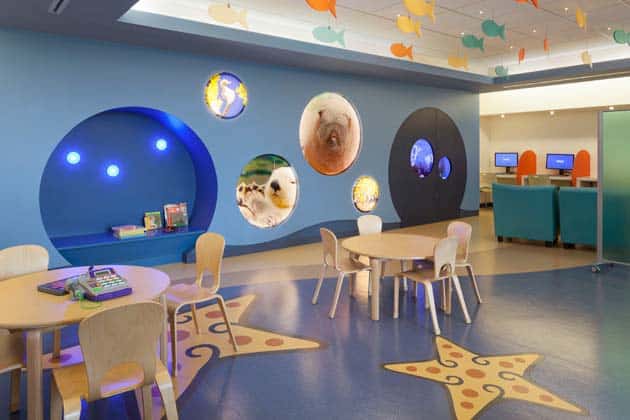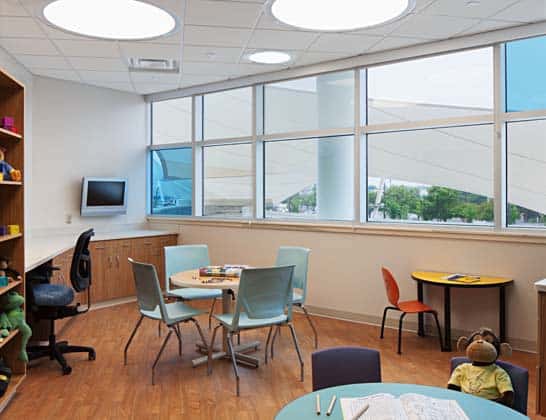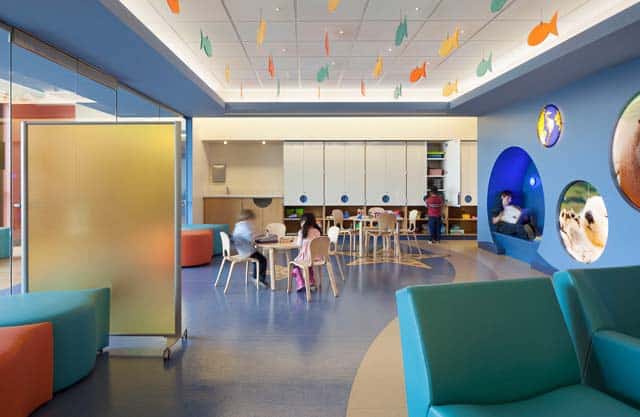Blog
Finding Space to Care for Kids of All Ages

Interior designer’s are always dealing with space issues. In Pediatrics, the challenges are even greater simply because kids come with more stuff. Katie Fricke, AIA, ACHA, NCARB, LEED AP, is a healthcare planning principal for HDR (Charlotte, N.C.). She recently submitted an great article to Healthcare Design Magazine on how to solve pediatric storage challenges. The article below shows two examples: the Mary Bridge Children’s Hospital in Tacoma, Washington; and, the Vidant Medical Center James and Connie Maynard Children’s Hospital in Greenville, North Carolina. The article specifically addresses three common challenges. One, creating space to appropriately serve younger and older kids. Second, finding space for positive distractions and third, making room for company.
Pediatric patients, while perhaps small in size, often come with more “stuff” than their adult counterparts. This makes planning for adequate storage in pediatric hospitals a challenge both in terms of how much storage is needed and the appropriate location to store that equipment and supplies.
Here are three primary reasons why programming for equipment in pediatric facilities differs from adult hospital planning—and some solutions for overcoming these issues.
1. Serving a Range of Ages

The children’s play area provides a lively getaway for patients and family members. Keeping true to the expansion’s nautical theme, fish figures dangle from the ceiling tiles, images of local sea life are found in cutouts in the wall, and starfish decals adorn the floor.
The first, and probably largest, reason for storage challenges in pediatric hospitals is the disparity in age ranges of the patient population. Pediatric care spans from infants to adolescents, with some organizations caring for patients up to 21 years of age. Therefore, a hospital must be equipped with several sizes of each piece of equipment needed to treat all these patients.
For example, in pediatric and PICU units, space must be allocated to store adult-sized beds for older children and cribs for infants and toddlers. For emergency equipment, hospitals need to have both adult and neonatal crash carts on hand, depending on the age of the child requiring resuscitation, as well as duplicate difficult airway carts for both pediatric and adult care. It’s even recommended that hospitals stock duplicate automated mediation dispensing systems to visibly and physically separate pediatric medications from the dosage amounts administered to older children.
Keeping these duplicate items on hand and stored near the clinical areas creates a location issue that must be resolved for patient and clinical workflows to remain efficient and smooth. Particularly for bulky items like bed storage, quick access is needed where space is often at a premium. As a result, this equipment can get pushed to more remote locations where it’s less accessible after hours or in an emergency.
Solution
Project teams need to anticipate these duplicate items from the initial project conception and upsize programs for medication and nourishment rooms, equipment rooms, and storage alcoves in corridors. Working closely with the equipment planner and facilities purchasing team to proactively develop an equipment list will help designers test the functionality of the individual spaces and see if these items fit in the desired locations. The American College of Emergency Physicians has some general guidelines for minimum pediatric equipment in the ED, but precise sizing is determined by the equipment selected. For example, in a recent pediatric ED project, the square footage of the original medication room had to be increased by more than 70 percent to accommodate the client’s desire to store duplicate automated medication dispensing systems.
2. Space for Positive Distractions

With a view to the outside, the Kids Immunosuppressive Special Unit (KISSU) activity room provides a place for the kids to go and play away from their room.
Being in the hospital can be scary and stressful for kids, especially younger ones who may not fully understand what’s happening or why, so pediatric hospitals place a priority on creating positive distractions for this vulnerable patient population. These features come in all sorts of forms, and many, of course, require storage. For example, some pediatric hospitals use brightly colored or themed wagons instead of traditional wheelchairs to transport patients (and some of their belongings or a favorite stuffed animal) between departments. This feels less institutional and more “normal” for a kid who may have a wagon at home and can symbolize the opportunity to leave the patient bed and get out and explore. Unlike wheelchairs, however, wagons typically don’t collapse or stack easily, resulting in a significant amount of floor area taken up when they’re not in use.
Child life specialists, who help kids and their families cope with the hospital experience, are another source of positive distractions, providing activities, educational programming, and therapeutic play for young patients using books, tablets and electronics, paper, coloring books, and toys. These specialists work in every pediatric department and need space throughout the hospital for consulting with families and interacting with the kids. They meet in dedicated child and teen play rooms, clinical areas like prep/recovery spaces in surgery and imaging, and inpatient rooms, as well as in informal spaces like waiting rooms and lobbies. Supplies need to be close at hand in each area to be helpful and timely, and, as with the beds and cribs, various sizes and duplicate items are necessary to serve multiple patient ages, which further impacts storage needs.
Solution
Because child life specialists’ storage needs present an entire equipment category that doesn’t exist in adult-only areas of the hospital, it’s important to engage the child life specialists and full project team early in the visioning to work through the implications of what will be stored and where. Will the wagons be centralized in a corral near the main entry or dispersed in alcoves throughout the departments? The Association of Child Life Professionals recommends in its Standards of Clinical Practice that the different types of child life areas have adequate storage to house the resources necessary to fulfil specialists’ therapeutic mission while ensuring security, privacy, and confidentiality. In EDs and other diagnostic areas, this may mean a central lockable closet that’s dedicated for this purpose but shared by a few departments. In play rooms, built-in cabinets, clever cubbies, storage benches, and niches can help add accessible storage.
3. Making Room for Company

The children’s play area provides a lively getaway for patients and family members. Keeping true to the expansion’s nautical theme, fish figures dangle from the ceiling tiles and images of local sea life are found in cutouts in the wall.
Further driving up the need for additional storage in a pediatric hospital is the fact that most pediatric patients arrive with a network of parents, siblings, and extended family. Overnight accommodations for larger families and siblings, additional seating, cots, linens, and blankets that don’t permanently reside in the patient rooms must be securely stored on the unit and be available to support the entire family when the need arises.
Solution
Decentralized equipment rooms serving a pod or neighborhood of patient rooms can be used to store equipment nearby while helping reduce the travel distance to haul equipment to a designated area. Parkland Hospital in Dallas, for example, utilizes a decentralized storage model in its NICU layout, which features 72 all-private patient rooms divided into neighborhoods of 12 rooms. The unit houses nine equipment storage rooms and 12 8-foot-deep equipment alcoves in decentralized locations to serve the pods, with most patient rooms located within 100 linear feet or less of equipment storage. The unit itself houses more than 2,100 square feet of storage.
More than minimum
For states that recognize the Facility Guidelines Institute’s Guidelines for Design and Construction as the health code, it’s important to note that the storage minimum requirements for certain departments, such as 10 square feet per bed for pediatric med/surg units and 20 square feet per bed in PICU units, are the same for the adult med/surg and ICU departments. Therefore, all the additional functional needs specific to the pediatric population aren’t necessarily accounted for in the code minimum. Duplicate emergency equipment, varying sized beds and cribs, separate medication dispensers, educational material and toys, and family sleeping accommodations exceed this minimum and should be factored into the project plan during the programming phase.
Lobbying for additional space when it’s at a premium isn’t easy, but all these items that come with caring for children will need a home so that corridors aren’t overcrowded with equipment on day one. Project teams should outline storage needs and the vision for how and where to incorporate supplies during programming. Just as important, teams will need to communicate and manage expectations that the functional needs will likely exceed the minimum code requirements for pediatric storage.
Katie Fricke, AIA, ACHA, NCARB, LEED AP, is a healthcare planning principal for HDR (Charlotte, N.C.). She can be reached at katie.fricke@hdrinc.com.
Source:
Fricke, Katie. “How To Solve Pediatric Storage Challenges.” HCD Magazine, 3 Jan. 2018, www.healthcaredesignmagazine.com/trends/operations-facility-management/solve-pediatric-storage-challenges/#slide-2.







